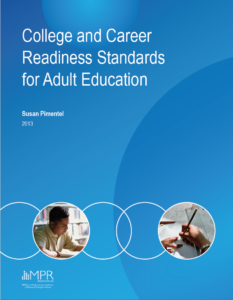- MN ABE Connect
- Archive
- Individualized and Collaborative Tasks for CCRS Implementation
 October 9, 2017
October 9, 2017
Individualized and Collaborative Tasks for CCRS Implementation
Burgen Young, Instructional ManagerLast year teachers at the Minnesota Literacy Council began the work of implementing the College & Career Readiness Standards as a team by participating in individual documentation projects and peer collaboration. These two professional development tasks gave the teachers both autonomy and structure as they took their first (or next) steps towards mastery of the standards. Many teachers chose to go above and beyond the expectations for the tasks, and their skill in implementing the standards grew exponentially as a result.
 For the individual documentation task, each teacher first chose an instructional goal focused on the standards. Goals included measuring text complexity, recognizing and formulating text-dependent questions, and designing numeracy routines that build conceptual understanding of base ten.
For the individual documentation task, each teacher first chose an instructional goal focused on the standards. Goals included measuring text complexity, recognizing and formulating text-dependent questions, and designing numeracy routines that build conceptual understanding of base ten.
Next, teachers documented an artifact of their choice to show growth towards their goals. One teacher chose to measure the complexity of several texts he used in instruction. Another teacher collected copies of the text dependent questions she wrote to accompany texts she often used in class. The teacher who focused on numeracy kept a teaching journal to track the success of activities and to note improvements for next time.
The instructors met with their supervisor twice during the year for “show and tell” sessions to talk through what they collected and what they were learning. The supervisor gave positive feedback on successes and provided coaching to suggest next steps. All teachers significantly increased their confidence level with the standards and expressed that they found them valuable.
In addition to individual documentation, all literacy council teachers participated in a simplified version of lesson study. They worked in pairs with instructors who teach a similar level or subject and chose an instructional question or goal related to the standards. This goal could be identical to the ones they worked on as individuals. They consulted at least one resource to inform their goal, and then designed a lesson, activity, or routine to address the goal. Next, they observed each other using the activity or lesson they had designed and made revisions based on what they observed. The last step was to document their goal, resources consulted, tools created, and lessons learned. They were asked to submit this form to their supervisor.
The results? Teachers collaborated to share CCRS resources, activities, and instructional strategies that fit the levels they teach.
This year teachers are continuing their efforts in standards alignment by evaluating the alignment of lessons and/or resources, filling out a CCRS Observation Tool about a lesson video, and using the CCRS Lesson Planning Template to improve the alignment of a lesson. After this year of strengthening alignment by learning and internalizing the content in the CCRS tools, literacy council professional development efforts will most likely return to setting individual goals and collecting artifacts to document growth.

Newsletter Signup
Get MN ABE Connect—the official source for ABE events, activities, and resources!
Sign UpArticle Categories
- ABE Foundations/Staff Onboarding
- ACES/Transitions
- Adult Career Pathways
- Assessment
- CCR Standards
- Citizenship
- COVID-19
- Cultural Competency
- Digital Literacy/Northstar
- Disabilities
- Distance Learning/Education
- ELA
- Equity/Inclusion
- ESL
- HSE/Adult Diploma
- Listening
- Math/Numeracy
- Mental Health
- Minnesota ABE
- One-Room Schoolhouse/Multilevel
- Professional Development
- Program Management
- Reading
- Remote Instruction
- Science
- Social Studies
- Speaking/Conversation
- Support Services
- Teaching Strategies
- Technology
- Uncategorized
- Volunteers/Tutors
- Writing